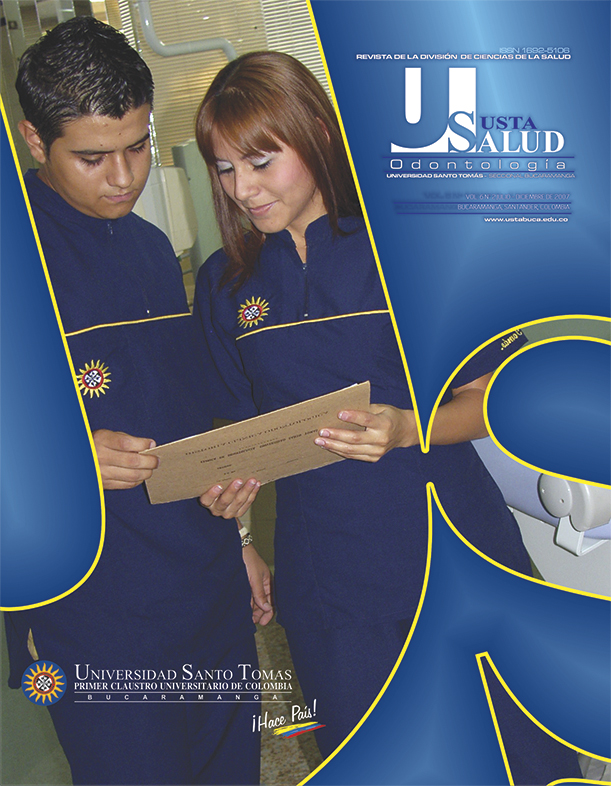HIPODONCIA: REPORTE DE UN CASO FAMILIAR
Resumen
La hipodoncia se define como la falta de uno a seis dientes, sin tener en cuenta a los terceros molares; es un evento que ocurre, en la dentición permanente, entre el 1.6% al 9.6% tanto en hombres como en mujeres. Se reporta un caso de hipodoncia familiar con un patrón de herencia autosómico recesivo, con ausencia de incisivo lateral izquierdo y segundos premolares en los cuatro cuadrantes, además de los terceros molares y microdoncia de incisivo lateral derecho.
[Aránzazu GC. Hipodoncia: Reporte de un caso familiar. Revista Ustasalud Odontología 2007; 6: 131 - 134]
Referencias
2. Jorgenson RJ. Clinician’s view of hypodontia. JADA 1980: 101: 283 – 286.
3. Pirinen S, Kentala A, Nieminen P, Varilo T, Thesleff I, Arte S. Recessively inherited lower incisor hypodontia J Med Genet 2001; 38: 551 – 556
4. Fekonja A. Hypodontia in orthodontically treated children. Eur J Orthod 2005; 27: 457 – 460.
5. Kirzioglu Z, Köseler Sentut T, Ozay Ertük MS, Karayilmaz H. Clinical features of hypodontia and associated dental anomalies: a retrospective study. Oral Diseases 2005; 11: 399 – 404.
6. Silva Meza R Radiographic assessment of congenitally missing teeth in orthodontic patients. Int J Paediatr Dent 2003; 13: 112 – 116.
7. Rasmussen P. Severe hypodontia: diversities in manifestations. J Clin Pediatr Dent 1999; 23: 179 – 188.
8. McKeown HF, Robinson DL, Elcock C, Al-Sharood M, Brook AH. Tooth dimensions in hypodontia patients, their unaffected relatives and a control group measured by a new image analysis system. Eur J Orthod 2002; 24: 131 – 141.
9. Miletich I, Sharpe PT. Normal and abnormal dental development. Hum Mol Genet 2003; 12: R69 – R73.
10. Kim JW, Simmer JP, Lin BPJ, Chu JC. Novel MSX2 frameshift causes autosomal dominant olygodontia. J Dent Res 2006; 85: 267 - 271.
11. Briceño I, Berrocal MC, González OA, Gutiérrez SJ, Ordoñez A, Torres D. Análisis clínico y molecular de la hipodoncia. Memorias IV - V Encuentro de Investigación en Ciencias Básicas en Odontología. URL disponible en: http://encolombia.com/odontologia/investigaciones/memorias-seminario.htm
12. Arboleda LA, Echeverri J, Restrepo LA, Marín ML, Vásquez G, Gómez JC, Manco HA, Pérez CM, Taborda E. Agenesia dental. Revisión bibliográfica y reporte de dos casos clínicos. Revista Facultad de Odontología Universidad de Antioquia 2006; 18: 47 – 54.
13. Bazán M. A congenitally missing canine in association with other dental disturbance: report of two cases. J Dent Child 1983; 50: 382 - 384.
14. Corrucini RS. An epidemiologic transition in dental occlusion in world populations. Am J Orthod 1984; 86: 419.
15. Correa MB, García-Robes M. Agenesia dentaria: Estudio familiar. Rev Cubana Ortod 1996; 11: 27 – 34.















